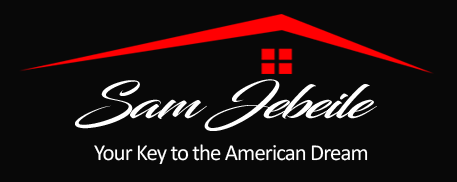 |
|
Anaheim (/ˈænəhaɪm/) is a city in Orange County, California, part of the Los Angeles metropolitan area. As of the 2010 United States Census, the city had a population of 336,265, making it the most populous city in Orange County and the 10th-most populous city in California. Anaheim is the second-largest city in Orange County in terms of land area, and is known for being the home of the Disneyland Resort, convention center, and its two major sports teams: the Anaheim Ducks ice hockey club and the Angels baseball team.
Anaheim was founded by fifty German families in 1857 and incorporated as the second city in Los Angeles County on March 18, 1876; Orange County would later be split off from Los Angeles County in 1889. Anaheim remained largely an agricultural community until Disneyland opened in 1955. This led to the construction of several hotels and motels around the area, and residential districts in Anaheim soon followed. The city also developed into an industrial center, producing electronics, aircraft parts and canned fruit. Anaheim is a charter city.
Anaheim's city limits extend from Cypress in the west to the Riverside County line in the east and encompass a diverse collection of neighborhoods and communities. Anaheim Hills is a master-planned[peacock term] community located in the city's eastern stretches that is home to many of the city's affluent.[citation needed] Downtown Anaheim has three mixed-use historic districts, the largest of which is the Anaheim Colony. The Anaheim Resort, a commercial district, includes the Disneyland Resort, with its two theme parks, multiple hotels, and retail district, and numerous hotels and retail complexes. The Platinum Triangle, a neo-urban redevelopment district surrounding Angel Stadium, is planned to be populated with mixed-use streets and high-rises. Anaheim Canyon is an industrial district north of California State Route 91 and east of California State Route 57.
HISTORY
Anaheim's name is a blend of Ana, after the nearby Santa Ana River, and German -heim meaning "home", which is also a common Germanic place name compound (compare Trondheim in Norway and many place names in Germany).
The city of Anaheim was founded in 1857 by 50 German-Americans who were residents of San Francisco and whose families had originated in Rothenburg ob der Tauber, Franconia in Bavaria.[citation needed] After traveling through the state looking for a suitable area to grow grapes, the group decided to purchase a 1,165 acres (4.71 km2) parcel from Juan Pacifico Ontiveros' large Rancho San Juan Cajon de Santa Ana in present-day Orange County for $2 per acre.
For $750 a share, the group formed the Anaheim Vineyard Company.Their new community was named Annaheim, meaning "home by the Santa Anna River" in German. The name later was altered to Anaheim. To the Spanish-speaking neighbors, the settlement was known as Campo Alemán (English: German Field).
Anaheim in 1890
Although grape and wine-making was their primary objective, the majority of the 50 settlers were mechanics, carpenters and craftsmen with no experience in wine-making. The community set aside 40 acres (16 ha) for a town center and a school was the first building erected there. The first home was built in 1857, the Anaheim Gazette newspaper was established in 1870 and a hotel in 1871. For 25 years, the area was the largest wine producer in California. However, in 1884, a disease infected the grape vines and by the following year the entire industry was destroyed. Other crops – walnuts, lemons and oranges – soon filled the void. Fruits and vegetables had become viable cash crops when the Los Angeles – Orange County region was connected to the continental railroad network in 1887.
Helena Modjeska
Polish actress Helena Modjeska settled in Anaheim with her husband and various friends, among them Henryk Sienkiewicz, Julian Sypniewski and Łucjan Paprocki. While living in Anaheim, Helena Modjeska became good friends with Clementine Langenberger, the second wife of August Langenberger. Helena Street and Clementine Street are named after these two ladies, and the streets are located adjacent to each other as a symbol of the strong friendship which Helena Modjeska and Clementine Lagenberger shared. Modjeska Park in West Anaheim, is also named after Helena Modjeska.
Early 20th Century
Anaheim High School, c. 1900
During the first half of the 20th century, before Disneyland opened its doors to the public, Anaheim was a massive rural community dominated by orange groves and the landowners who farmed them. One of the landowners was Bennett Payne Baxter, who owned much land in northeast Anaheim that today is the location of Angel Stadium. He came up with many new ideas for irrigating orange groves and shared his ideas with other landowners. He was not only successful, he helped other landowners and businesspeople succeed as well. Ben Baxter and other landowners helped to make Anaheim a thriving rural community before Disneyland changed the city forever. Today, a street runs along Edison Park which is named Baxter Street. Also during this time, Rudolph Boysen served as Anaheim's first Park Superintendent from 1921 to 1950. Boysen created a hybrid berry which Walter Knott later named the boysenberry, after Rudy Boysen. Boysen Park in East Anaheim was also named after him.
Anaheim in 1922
In 1924, Ku Klux Klan members were elected to the Anaheim City Council on a platform of political reform. Up until that point, the city had been controlled by a long-standing business and civic elite that was mostly German American. Given their tradition of moderate social drinking, the German Americans did not strongly support prohibition laws of the day. The mayor himself was a former saloon keeper. Led by the minister of the First Christian Church, the Klan represented a rising group of politically oriented non-ethnic Germans who denounced the elite as corrupt, undemocratic, and self-serving. The Klansmen aimed to create what they saw as a model, orderly community, one in which prohibition against alcohol would be strictly enforced. At the time, the KKK had about 1200 members in Orange County. The economic and occupational profile of the pro and anti-Klan groups shows the two were similar and about equally prosperous. Klan members were Protestants, as were the majority of their opponents; however, the opposition to the Klan also included many Catholic Germans. Individuals who joined the Klan had earlier demonstrated a much higher rate of voting and civic activism than did their opponents, and many of the individuals in Orange County who joined the Klan did so out of a sense of civic activism. Upon easily winning the local Anaheim election in April 1924, the Klan representatives promptly fired city employees who were known to be Catholic and replaced them with Klan appointees. The new city council tried to enforce prohibition. After its victory, the Klan chapter held large rallies and initiation ceremonies over the summer.
The opposition to KKK's hold on Anaheim politics organized, bribed a Klansman for their secret membership list, and exposed the Klansmen running in the state primaries; they defeated most of the candidates. Klan opponents in 1925 took back local government, and succeeded in a special election in recalling the Klansmen who had been elected in April 1924. The Klan in Anaheim quickly collapsed, its newspaper closed after losing a libel suit, and the minister who led the local Klavern moved to Kansas. |
| Anaheim School Information Courtesy of Sam Jebeile |
| |
|
|
| |
| Anaheim Community Map Courtesy of Sam Jebeile |
|
|
| Send Message to Sam Jebeile |
|
|
|
- Broadmoor Homes / Royal Ridge
- Canyon Oaks / Savi Ranch West
- Carriage Hills / Havenhill
- E Bridgewood Dr / S Canyon Garden Ln
- Friendly Village / Parkside
- Lake Summit / Galerie
- Rancho Yorba / Westridge
- Southeast Anaheim
- Sunflower / Bel Air
- The Summit of Anaheim Hills
- Broadmoor Homes / Royal Ridge
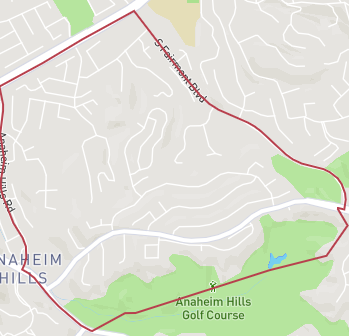
REAL ESTATE PRICES & OVERVIEW
Broadmoor Homes / Royal Ridge median real estate price is $1,174,918, which is more expensive than 81.0% of the neighborhoods in California and 95.8% of the neighborhoods in the U.S.
The average rental price in Broadmoor Homes / Royal Ridge is currently $5,570, based on NeighborhoodScout's exclusive analysis. The average rental cost in this neighborhood is higher than 93.1% of the neighborhoods in California.
Broadmoor Homes / Royal Ridge is a suburban neighborhood (based on population density) located in Anaheim, California.
Broadmoor Homes / Royal Ridge real estate is primarily made up of medium sized (three or four bedroom) to large (four, five or more bedroom) single-family homes and small apartment buildings. Most of the residential real estate is owner occupied. Many of the residences in the Broadmoor Homes / Royal Ridge neighborhood are established but not old, having been built between 1970 and 1999. A number of residences were also built between 2000 and the present.
In Broadmoor Homes / Royal Ridge, the current vacancy rate is 0.2%, which is a lower rate of vacancies than 93.5% of all neighborhoods in the U.S. This means that the housing supply in Broadmoor Homes / Royal Ridge is very tight compared to the demand for property here.
NOTABLE & UNIQUE NEIGHBORHOOD CHARACTERISTICS
Many things matter about a neighborhood, but the first thing most people notice is the way a neighborhood looks and its particular character. For example, one might notice whether the buildings all date from a certain time period or whether shop signs are in multiple languages. This particular neighborhood in Anaheim, the Broadmoor Homes / Royal Ridge neighborhood, has some outstanding things about the way it looks and its way of life that are worth highlighting.
Real Estate
Most neighborhoods are composed of a mixture of ages of homes, but the Broadmoor Homes / Royal Ridge stands out as rather unique in having nearly all of its residential real estate built in one time period, namely between 1970 and 1999, generally considered to be established, but not old housing. What you'll sense when you look around or drive the streets of this neighborhood is that many of the residences look the same because of this similarity of age. In fact, 90.9% of the residential real estate here was built in this one time period.
In addition, one way that the Broadmoor Homes / Royal Ridge neighborhood really stands out, is that it has more large 4, 5, or additional bedroom homes and real estate than 96.6% of the neighborhoods in America. When you walk or drive around this neighborhood, you'll instantly notice the size of the homes here which definitely makes a strong visual statement.
People
The Broadmoor Homes / Royal Ridge neighborhood is considered a solid choice for executive lifestyles. NeighborhoodScout's analysis ranks it as better than 94.4% of California neighborhoods for executive living, based on the wealthy, educated professionals, executives, and managers who choose to reside here, the spacious homes that are prominent features of the real estate in the neighborhood, and the high real estate appreciation rates found here relative to other neighborhoods in the state. In addition to being an excellent choice for highly educated executives, this neighborhood is also a very good choice for families with school-aged children.
Diversity
Did you know that the Broadmoor Homes / Royal Ridge neighborhood has more Iranian and Croatian ancestry people living in it than nearly any neighborhood in America? It's true! In fact, 4.1% of this neighborhood's residents have Iranian ancestry and 0.8% have Croatian ancestry.
Broadmoor Homes / Royal Ridge is also pretty special linguistically. Significantly, 7.4% of its residents five years old and above primarily speak Persian at home. While this may seem like a small percentage, it is higher than 99.9% of the neighborhoods in America.
THE NEIGHBORS
How wealthy a neighborhood is, from very wealthy, to middle income, to low income is very formative with regard to the personality and character of a neighborhood. Equally important is the rate of people, particularly children, who live below the federal poverty line. In some wealthy gated communities, the areas immediately surrounding can have high rates of childhood poverty, which indicates other social issues. NeighborhoodScout's analysis reveals both aspects of income and poverty for this neighborhood.
The neighbors in the Broadmoor Homes / Royal Ridge neighborhood in Anaheim are wealthy, making it among the 15% highest income neighborhoods in America. NeighborhoodScout's exclusive analysis reveals that this neighborhood has a higher income than 94.0% of the neighborhoods in America. In addition, 7.7% of the children seventeen and under living in this neighborhood are living below the federal poverty line, which is a lower rate of childhood poverty than is found in 57.2% of America's neighborhoods.
What we choose to do for a living reflects who we are. Each neighborhood has a different mix of occupations represented, and together these tell you about the neighborhood and help you understand if this neighborhood may fit your lifestyle.
In the Broadmoor Homes / Royal Ridge neighborhood, 63.8% of the working population is employed in executive, management, and professional occupations. The second most important occupational group in this neighborhood is sales and service jobs, from major sales accounts, to working in fast food restaurants, with 21.7% of the residents employed. Other residents here are employed in manufacturing and laborer occupations (7.8%), and 6.7% in clerical, assistant, and tech support occupations.
Languages
The languages spoken by people in this neighborhood are diverse. These are tabulated as the languages people preferentially speak when they are at home with their families. The most common language spoken in the Broadmoor Homes / Royal Ridge neighborhood is English, spoken by 76.7% of households. Other important languages spoken here include Persian, Spanish and Korean.
Ethnicity / Ancestry
Boston's Beacon Hill blue-blood streets, Brooklyn's Orthodox Jewish enclaves, Los Angeles' Persian neighborhoods. Each has its own culture derived primarily from the ancestries and culture of the residents who call these neighborhoods home. Likewise, each neighborhood in America has its own culture – some more unique than others – based on lifestyle, occupations, the types of households – and importantly – on the ethnicities and ancestries of the people who live in the neighborhood. Understanding where people came from, who their grandparents or great-grandparents were, can help you understand how a neighborhood is today.
In the Broadmoor Homes / Royal Ridge neighborhood in Anaheim, CA, residents most commonly identify their ethnicity or ancestry as German (13.5%). There are also a number of people of Asian ancestry (10.0%), and residents who report Italian roots (9.7%), and some of the residents are also of Mexican ancestry (8.5%), along with some English ancestry residents (7.7%), among others. In addition, 15.6% of the residents of this neighborhood were born in another country.
GETTING TO WORK
Even if your neighborhood is walkable, you may still have to drive to your place of work. Some neighborhoods are located where many can get to work in just a few minutes, while others are located such that most residents have a long and arduous commute. The greatest number of commuters in Broadmoor Homes / Royal Ridge neighborhood spend between 15 and 30 minutes commuting one-way to work (34.4% of working residents), which is shorter than the time spent commuting to work for most Americans.
Here most residents (70.4%) drive alone in a private automobile to get to work. In addition, quite a number also carpool with coworkers, friends, or neighbors to get to work (13.4%) . In a neighborhood like this, as in most of the nation, many residents find owning a car useful for getting to work.
- Canyon Oaks / Savi Ranch West
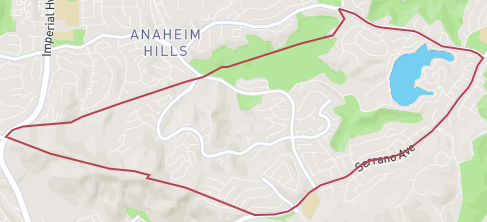
REAL ESTATE PRICES & OVERVIEW
Canyon Oaks / Savi Ranch West median real estate price is $1,059,540, which is more expensive than 74.9% of the neighborhoods in California and 94.4% of the neighborhoods in the U.S.
The average rental price in Canyon Oaks / Savi Ranch West is currently $3,846, based on NeighborhoodScout's exclusive analysis. The average rental cost in this neighborhood is higher than 67.5% of the neighborhoods in California.
Canyon Oaks / Savi Ranch West is a suburban neighborhood (based on population density) located in Anaheim, California.
Canyon Oaks / Savi Ranch West real estate is primarily made up of medium sized (three or four bedroom) to large (four, five or more bedroom) single-family homes and apartment complexes/high-rise apartments. Most of the residential real estate is owner occupied. Many of the residences in the Canyon Oaks / Savi Ranch West neighborhood are established but not old, having been built between 1970 and 1999. A number of residences were also built between 1940 and 1969.
In Canyon Oaks / Savi Ranch West, the current vacancy rate is 1.0%, which is a lower rate of vacancies than 91.8% of all neighborhoods in the U.S. This means that the housing supply in Canyon Oaks / Savi Ranch West is very tight compared to the demand for property here.
NOTABLE & UNIQUE NEIGHBORHOOD CHARACTERISTICS
When you see a neighborhood for the first time, the most important thing is often the way it looks, like its homes and its setting. Some places look the same, but they only reveal their true character after living in them for a while because they contain a unique mix of occupational or cultural groups. This neighborhood is very unique in some important ways, according to NeighborhoodScout's exclusive exploration and analysis.
People
Of note is NeighborhoodScout's research finding that the Canyon Oaks / Savi Ranch West neighborhood has some of the lowest rates of children living in poverty of any neighborhood in the United States. In a nation where approximately 1 in 4 children are living in poverty, the Canyon Oaks / Savi Ranch West community truly stands out from the rest in this regard.
In addition, neighborhoodScout's analysis shows that the Canyon Oaks / Savi Ranch West neighborhood has a greater concentration of residents currently enrolled in college than 95.1% of the neighborhoods in the U.S. With 10.9% of the population here attending college, this is very much a college-focused neighborhood.
Also, the Canyon Oaks / Savi Ranch West neighborhood stands out within California for its college student friendly environment. NeighborhoodScout's analysis reveals that this neighborhood is home to a number of college students, is relatively walkable, and above average in safety. In combination, this makes it stand out for a good place for college students to consider. Because a number of college students live here, this neighborhood may be close to a college campus and offer certain amenities nearby geared towards the student body. While it's not an environment for everyone, ambitious scholars can enjoy seasonal excitement between semesters and school breaks, and parents can rest easy knowing that the area has an above average safety rating. For each of these reasons, the neighborhood is rated among the top 5.3% of college-friendly places to live in CA. In addition to being an excellent choice for college students, this neighborhood is also a very good choice for families with school-aged children.
Occupations
The Canyon Oaks / Savi Ranch West neighborhood has a greater proportion of government workers living in it than 96.2% of the neighborhoods in America, according to NeighborhoodScout's exclusive analysis. This is a unique feature of this neighborhood, and one that shapes its character.
Real Estate
Most neighborhoods are composed of a mixture of ages of homes, but the Canyon Oaks / Savi Ranch West stands out as rather unique in having nearly all of its residential real estate built in one time period, namely between 1970 and 1999, generally considered to be established, but not old housing. What you'll sense when you look around or drive the streets of this neighborhood is that many of the residences look the same because of this similarity of age. In fact, 83.8% of the residential real estate here was built in this one time period.
Diversity
Did you know that the Canyon Oaks / Savi Ranch West neighborhood has more Iranian and Armenian ancestry people living in it than nearly any neighborhood in America? It's true! In fact, 1.6% of this neighborhood's residents have Iranian ancestry and 0.6% have Armenian ancestry.
Canyon Oaks / Savi Ranch West is also pretty special linguistically. Significantly, 1.8% of its residents five years old and above primarily speak Persian at home. While this may seem like a small percentage, it is higher than 98.9% of the neighborhoods in America.
Migration / Stability
Some neighborhoods have more internal cohesiveness than others. While other neighborhoods feel like a collection of strangers who just happen to live near each other. Sometimes this comes down to not only the personalities of the people in a place, but how long people have been together in that neighborhood. NeighborhoodScout's research has revealed some interesting things about the rootedness of people in the Canyon Oaks / Savi Ranch West neighborhood. More residents of the Canyon Oaks / Savi Ranch West neighborhood live here today that also were living in this same neighborhood five years ago than is found in 96.8% of U.S. neighborhoods. This neighborhood is really made up of people who know each other, don't move often, and have lived here in this very neighborhood for quite a while.
THE NEIGHBORS
There are two complementary measures for understanding the income of a neighborhood's residents: the average and the extremes. While a neighborhood may be relatively wealthy overall, it is equally important to understand the rate of people - particularly children - who are living at or below the federal poverty line, which is extremely low income. Some neighborhoods with a lower average income may actually have a lower childhood poverty rate than another with a higher average income, and this helps us understand the conditions and character of a neighborhood.
The neighbors in the Canyon Oaks / Savi Ranch West neighborhood in Anaheim are wealthy, making it among the 15% highest income neighborhoods in America. NeighborhoodScout's exclusive analysis reveals that this neighborhood has a higher income than 91.4% of the neighborhoods in America. In addition, 0.0% of the children seventeen and under living in this neighborhood are living below the federal poverty line, which is a lower rate of childhood poverty than is found in 100.0% of America's neighborhoods.
What we choose to do for a living reflects who we are. Each neighborhood has a different mix of occupations represented, and together these tell you about the neighborhood and help you understand if this neighborhood may fit your lifestyle.
In the Canyon Oaks / Savi Ranch West neighborhood, 53.0% of the working population is employed in executive, management, and professional occupations. The second most important occupational group in this neighborhood is sales and service jobs, from major sales accounts, to working in fast food restaurants, with 26.2% of the residents employed. Other residents here are employed in government jobs, whether they are in local, state, or federal positions (14.0%), and 13.7% in clerical, assistant, and tech support occupations.
Languages
The languages spoken by people in this neighborhood are diverse. These are tabulated as the languages people preferentially speak when they are at home with their families. The most common language spoken in the Canyon Oaks / Savi Ranch West neighborhood is English, spoken by 75.4% of households. Other important languages spoken here include Spanish, Langs. of India, Vietnamese and Polish.
Ethnicity / Ancestry
Boston's Beacon Hill blue-blood streets, Brooklyn's Orthodox Jewish enclaves, Los Angeles' Persian neighborhoods. Each has its own culture derived primarily from the ancestries and culture of the residents who call these neighborhoods home. Likewise, each neighborhood in America has its own culture – some more unique than others – based on lifestyle, occupations, the types of households – and importantly – on the ethnicities and ancestries of the people who live in the neighborhood. Understanding where people came from, who their grandparents or great-grandparents were, can help you understand how a neighborhood is today.
In the Canyon Oaks / Savi Ranch West neighborhood in Anaheim, CA, residents most commonly identify their ethnicity or ancestry as Mexican (18.8%). There are also a number of people of German ancestry (16.7%), and residents who report Asian roots (13.5%), and some of the residents are also of Irish ancestry (11.8%), along with some English ancestry residents (5.3%), among others. In addition, 20.7% of the residents of this neighborhood were born in another country.
GETTING TO WORK
How you get to work – car, bus, train or other means – and how much of your day it takes to do so is a large quality of life and financial issue. Especially with gasoline prices rising and expected to continue doing so, the length and means of one's commute can be a financial burden. Some neighborhoods are physically located so that many residents have to drive in their own car, others are set up so many walk to work, or can take a train, bus, or bike. The greatest number of commuters in Canyon Oaks / Savi Ranch West neighborhood spend under 15 minutes commuting one-way to work (34.3% of working residents), one of the shortest commutes across America.
Here most residents (86.0%) drive alone in a private automobile to get to work. In a neighborhood like this, as in most of the nation, many residents find owning a car useful for getting to work.
- Carriage Hills / Havenhill
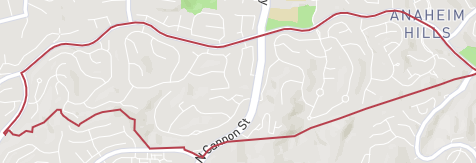
REAL ESTATE PRICES & OVERVIEW
Carriage Hills / Havenhill median real estate price is $1,129,344, which is more expensive than 78.4% of the neighborhoods in California and 95.2% of the neighborhoods in the U.S.
The average rental price in Carriage Hills / Havenhill is currently $6,419, based on NeighborhoodScout's exclusive analysis. The average rental cost in this neighborhood is higher than 98.7% of the neighborhoods in California.
Carriage Hills / Havenhill is a suburban neighborhood (based on population density) located in Anaheim, California.
Carriage Hills / Havenhill real estate is primarily made up of medium sized (three or four bedroom) to large (four, five or more bedroom) single-family homes and townhomes. Most of the residential real estate is owner occupied. Many of the residences in the Carriage Hills / Havenhill neighborhood are established but not old, having been built between 1970 and 1999. A number of residences were also built between 1940 and 1969.
In Carriage Hills / Havenhill, the current vacancy rate is 2.7%, which is a lower rate of vacancies than 83.4% of all neighborhoods in the U.S. This means that the housing supply in Carriage Hills / Havenhill is very tight compared to the demand for property here.
NOTABLE & UNIQUE NEIGHBORHOOD CHARACTERISTICS
When you see a neighborhood for the first time, the most important thing is often the way it looks, like its homes and its setting. Some places look the same, but they only reveal their true character after living in them for a while because they contain a unique mix of occupational or cultural groups. This neighborhood is very unique in some important ways, according to NeighborhoodScout's exclusive exploration and analysis.
Real Estate
Most neighborhoods are composed of a mixture of ages of homes, but the Carriage Hills / Havenhill stands out as rather unique in having nearly all of its residential real estate built in one time period, namely between 1970 and 1999, generally considered to be established, but not old housing. What you'll sense when you look around or drive the streets of this neighborhood is that many of the residences look the same because of this similarity of age. In fact, 94.8% of the residential real estate here was built in this one time period.
People
The Carriage Hills / Havenhill neighborhood is considered a solid choice for executive lifestyles. NeighborhoodScout's analysis ranks it as better than 91.2% of California neighborhoods for executive living, based on the wealthy, educated professionals, executives, and managers who choose to reside here, the spacious homes that are prominent features of the real estate in the neighborhood, and the high real estate appreciation rates found here relative to other neighborhoods in the state. In addition to being an excellent choice for highly educated executives, this neighborhood is also a very good choice for college students, active retirees and urban sophisticates.
Diversity
Did you know that the Carriage Hills / Havenhill neighborhood has more Iranian and Russian ancestry people living in it than nearly any neighborhood in America? It's true! In fact, 6.6% of this neighborhood's residents have Iranian ancestry and 3.6% have Russian ancestry.
Carriage Hills / Havenhill is also pretty special linguistically. Significantly, 1.3% of its residents five years old and above primarily speak Persian at home. While this may seem like a small percentage, it is higher than 98.3% of the neighborhoods in America.
THE NEIGHBORS
There are two complementary measures for understanding the income of a neighborhood's residents: the average and the extremes. While a neighborhood may be relatively wealthy overall, it is equally important to understand the rate of people - particularly children - who are living at or below the federal poverty line, which is extremely low income. Some neighborhoods with a lower average income may actually have a lower childhood poverty rate than another with a higher average income, and this helps us understand the conditions and character of a neighborhood.
The neighbors in the Carriage Hills / Havenhill neighborhood in Anaheim are wealthy, making it among the 15% highest income neighborhoods in America. NeighborhoodScout's exclusive analysis reveals that this neighborhood has a higher income than 91.8% of the neighborhoods in America. In addition, 3.5% of the children seventeen and under living in this neighborhood are living below the federal poverty line, which is a lower rate of childhood poverty than is found in 70.1% of America's neighborhoods.
A neighborhood is far different if it is dominated by enlisted military personnel rather than people who earn their living by farming. It is also different if most of the neighbors are clerical support or managers. What is wonderful is the sheer diversity of neighborhoods, allowing you to find the type that fits your lifestyle and aspirations.
In the Carriage Hills / Havenhill neighborhood, 66.5% of the working population is employed in executive, management, and professional occupations. The second most important occupational group in this neighborhood is sales and service jobs, from major sales accounts, to working in fast food restaurants, with 16.2% of the residents employed. Other residents here are employed in clerical, assistant, and tech support occupations (13.4%), and 8.4% in government jobs, whether they are in local, state, or federal positions.
Languages
The languages spoken by people in this neighborhood are diverse. These are tabulated as the languages people preferentially speak when they are at home with their families. The most common language spoken in the Carriage Hills / Havenhill neighborhood is English, spoken by 74.4% of households. Other important languages spoken here include Spanish and Chinese.
Ethnicity / Ancestry
Boston's Beacon Hill blue-blood streets, Brooklyn's Orthodox Jewish enclaves, Los Angeles' Persian neighborhoods. Each has its own culture derived primarily from the ancestries and culture of the residents who call these neighborhoods home. Likewise, each neighborhood in America has its own culture – some more unique than others – based on lifestyle, occupations, the types of households – and importantly – on the ethnicities and ancestries of the people who live in the neighborhood. Understanding where people came from, who their grandparents or great-grandparents were, can help you understand how a neighborhood is today.
In the Carriage Hills / Havenhill neighborhood in Anaheim, CA, residents most commonly identify their ethnicity or ancestry as Asian (15.3%). There are also a number of people of German ancestry (13.1%), and residents who report English roots (12.9%), and some of the residents are also of Mexican ancestry (11.0%), along with some Irish ancestry residents (7.0%), among others. In addition, 22.7% of the residents of this neighborhood were born in another country.
GETTING TO WORK
How you get to work – car, bus, train or other means – and how much of your day it takes to do so is a large quality of life and financial issue. Especially with gasoline prices rising and expected to continue doing so, the length and means of one's commute can be a financial burden. Some neighborhoods are physically located so that many residents have to drive in their own car, others are set up so many walk to work, or can take a train, bus, or bike. The greatest number of commuters in Carriage Hills / Havenhill neighborhood spend between 15 and 30 minutes commuting one-way to work (34.5% of working residents), which is shorter than the time spent commuting to work for most Americans.
Here most residents (82.7%) drive alone in a private automobile to get to work. In addition, quite a number also carpool with coworkers, friends, or neighbors to get to work (6.3%) . In a neighborhood like this, as in most of the nation, many residents find owning a car useful for getting to work.
- E Bridgewood Dr / S Canyon Garden Ln
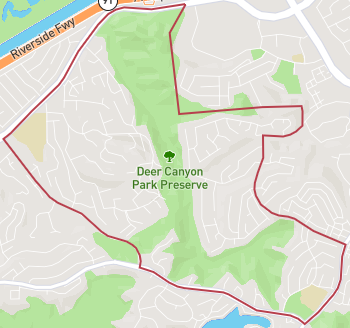
ABOUT ANAHEIM, CA
(E BRIDGEWOOD DR / S CANYON GARDEN LN)
Real Estate Prices and Overview
E Bridgewood Dr / S Canyon Garden Ln median real estate price is $1,139,053, which is more expensive than 88.0% of the neighborhoods in California and 97.7% of the neighborhoods in the U.S.
The average rental price in E Bridgewood Dr / S Canyon Garden Ln is currently $5,053, based on NeighborhoodScout's exclusive analysis. The average rental cost in this neighborhood is higher than 98.0% of the neighborhoods in California.
E Bridgewood Dr / S Canyon Garden Ln is a suburban neighborhood (based on population density) located in Anaheim, California.
E Bridgewood Dr / S Canyon Garden Ln real estate is primarily made up of medium sized (three or four bedroom) to large (four, five or more bedroom) single-family homes and townhomes. Most of the residential real estate is owner occupied. Many of the residences in the E Bridgewood Dr / S Canyon Garden Ln neighborhood are established but not old, having been built between 1970 and 1999. A number of residences were also built between 1940 and 1969.
In E Bridgewood Dr / S Canyon Garden Ln, the current vacancy rate is 1.6%, which is a lower rate of vacancies than 93.9% of all neighborhoods in the U.S. This means that the housing supply in E Bridgewood Dr / S Canyon Garden Ln is very tight compared to the demand for property here.
Notable & Unique Neighborhood Characteristics
The way a neighborhood looks and feels when you walk or drive around it, from its setting, its buildings, and its flavor, can make all the difference. This neighborhood has some really cool things about the way it looks and feels as revealed by NeighborhoodScout's exclusive research. This might include anything from the housing stock to the types of households living here to how people get around.
Notable & Unique: People
Wealth makes most things in life easier, and a few things harder. If you are wealthy and enjoy keeping up with the Jones', this neighborhood will interest you. In fact, according to NeighborhoodScout's research, the E Bridgewood Dr / S Canyon Garden Ln neighborhood is wealthier than 98.7% of the neighborhoods in the United States. Residents here are truly in a unique situation even when compared to other Americans, based on the sheer amount of wealth concentrated here. Even in times of economic downturn, residents of this neighborhood, as a group, suffered less and recovered more quickly. This is indeed a stand-out characteristic of this neighborhood. As one would expect in a considerably wealthy neighborhood such as this, E Bridgewood Dr / S Canyon Garden Ln also has one of the lowest ratings of child poverty in the nation.
In addition, according to NeighborhoodScout's exclusive analysis, E Bridgewood Dr / S Canyon Garden Ln is among the best neighborhoods for families in California. In fact, this neighborhood is more family-friendly than 98.2% of neighborhoods in the entire state of California. Its combination of top public schools, low crime rates, and owner-occupied single family homes gives this area the look and feel of a "Leave It to Beaver" episode. Many other families also live here, making it easy to socialize and develop a strong sense of community. In addition, the high number of college-educated parents influences the academic success of the local schools. Overall, you will find all of the amenities a family needs to thrive in the E Bridgewood Dr / S Canyon Garden Ln neighborhood. In addition to being an excellent choice for families with school-aged children, this neighborhood is also a very good choice for highly educated executives and urban sophisticates.
Notable & Unique: Real Estate
One way that the E Bridgewood Dr / S Canyon Garden Ln neighborhood really stands out, is that it has more large 4, 5, or additional bedroom homes and real estate than 98.8% of the neighborhoods in America. When you walk or drive around this neighborhood, you'll instantly notice the size of the homes here which definitely makes a strong visual statement.
In addition, real estate in the E Bridgewood Dr / S Canyon Garden Ln neighborhood is almost exclusively owner-occupied. NeighborhoodScout's analysis reveals that this neighborhood has a higher rate of owner-occupied housing than is found in 97.9% of U.S. neighborhoods. If you are seeking to rent, this neighborhood may not have many options, but high rates of ownership often indicate stability in a neighborhood.
Furthermore, some neighborhoods are made up of apartments. Some consist of row houses, and most - by far - consist of a mixture of housing types. But the E Bridgewood Dr / S Canyon Garden Ln neighborhood stands out due to the total dominance of detached, single-family homes here. There are nearly no other types of residential real estate in the neighborhood. In fact, this neighborhood has a higher proportion of single-family homes in its real estate stock than 95.9% of all American neighborhoods.
Also of note, most neighborhoods are composed of a mixture of ages of homes, but the E Bridgewood Dr / S Canyon Garden Ln stands out as rather unique in having nearly all of its residential real estate built in one time period, namely between 1970 and 1999, generally considered to be established, but not old housing. What you'll sense when you look around or drive the streets of this neighborhood is that many of the residences look the same because of this similarity of age. In fact, 84.5% of the residential real estate here was built in this one time period.
Notable & Unique: Modes of Transportation
While most Americans do drive to work alone each day, the E Bridgewood Dr / S Canyon Garden Ln neighborhood stands out by having 94.3% of commuters doing so, which is a higher proportion of people driving alone to work than NeighborhoodScout found in 96.8% of all American neighborhoods.
Notable & Unique: Diversity
Did you know that the E Bridgewood Dr / S Canyon Garden Ln neighborhood has more Iranian and Lebanese ancestry people living in it than nearly any neighborhood in America? It's true! In fact, 2.7% of this neighborhood's residents have Iranian ancestry and 1.9% have Lebanese ancestry.
E Bridgewood Dr / S Canyon Garden Ln is also pretty special linguistically. Significantly, 2.7% of its residents five years old and above primarily speak Persian at home. While this may seem like a small percentage, it is higher than 99.4% of the neighborhoods in America.
The Neighbors
The Neighbors: Income
How wealthy a neighborhood is, from very wealthy, to middle income, to low income is very formative with regard to the personality and character of a neighborhood. Equally important is the rate of people, particularly children, who live below the federal poverty line. In some wealthy gated communities, the areas immediately surrounding can have high rates of childhood poverty, which indicates other social issues. NeighborhoodScout's analysis reveals both aspects of income and poverty for this neighborhood.
The neighbors in the E Bridgewood Dr / S Canyon Garden Ln neighborhood in Anaheim are wealthy, making it among the 15% highest income neighborhoods in America. NeighborhoodScout's exclusive analysis reveals that this neighborhood has a higher income than 98.7% of the neighborhoods in America. In addition, 0.0% of the children seventeen and under living in this neighborhood are living below the federal poverty line, which is a lower rate of childhood poverty than is found in 100.0% of America's neighborhoods.
The Neighbors: Occupations
The old saying "you are what you eat" is true. But it is also true that you are what you do for a living. The types of occupations your neighbors have shape their character, and together as a group, their collective occupations shape the culture of a place.
In the E Bridgewood Dr / S Canyon Garden Ln neighborhood, 60.1% of the working population is employed in executive, management, and professional occupations. The second most important occupational group in this neighborhood is sales and service jobs, from major sales accounts, to working in fast food restaurants, with 22.9% of the residents employed. Other residents here are employed in clerical, assistant, and tech support occupations (12.9%), and 4.0% in manufacturing and laborer occupations.
The Neighbors: Languages
The languages spoken by people in this neighborhood are diverse. These are tabulated as the languages people preferentially speak when they are at home with their families. The most common language spoken in the E Bridgewood Dr / S Canyon Garden Ln neighborhood is English, spoken by 72.8% of households. Other important languages spoken here include Langs. of India, Korean, Spanish and Persian.
The Neighbors: Ethnicity / Ancestry
Boston's Beacon Hill blue-blood streets, Brooklyn's Orthodox Jewish enclaves, Los Angeles' Persian neighborhoods. Each has its own culture derived primarily from the ancestries and culture of the residents who call these neighborhoods home. Likewise, each neighborhood in America has its own culture – some more unique than others – based on lifestyle, occupations, the types of households – and importantly – on the ethnicities and ancestries of the people who live in the neighborhood. Understanding where people came from, who their grandparents or great-grandparents were, can help you understand how a neighborhood is today.
In the E Bridgewood Dr / S Canyon Garden Ln neighborhood in Anaheim, CA, residents most commonly identify their ethnicity or ancestry as Asian (21.4%). There are also a number of people of Mexican ancestry (10.2%), and residents who report Irish roots (9.6%), and some of the residents are also of English ancestry (8.8%), along with some German ancestry residents (8.2%), among others. In addition, 23.2% of the residents of this neighborhood were born in another country.
Getting to Work
How you get to work – car, bus, train or other means – and how much of your day it takes to do so is a large quality of life and financial issue. Especially with gasoline prices rising and expected to continue doing so, the length and means of one's commute can be a financial burden. Some neighborhoods are physically located so that many residents have to drive in their own car, others are set up so many walk to work, or can take a train, bus, or bike. The greatest number of commuters in E Bridgewood Dr / S Canyon Garden Ln neighborhood spend between 15 and 30 minutes commuting one-way to work (33.0% of working residents), which is shorter than the time spent commuting to work for most Americans.
Here most residents (94.3%) drive alone in a private automobile to get to work. In a neighborhood like this, as in most of the nation, many residents find owning a car useful for getting to work.
- Friendly Village / Parkside
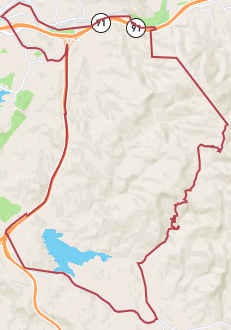
REAL ESTATE PRICES & OVERVIEW
Friendly Village / Parkside median real estate price is $1,080,274, which is more expensive than 75.9% of the neighborhoods in California and 94.6% of the neighborhoods in the U.S.
The average rental price in Friendly Village / Parkside is currently $4,114, based on NeighborhoodScout's exclusive analysis. The average rental cost in this neighborhood is higher than 73.2% of the neighborhoods in California.
Friendly Village / Parkside is an urban neighborhood (based on population density) located in Anaheim, California.
Friendly Village / Parkside real estate is primarily made up of medium sized (three or four bedroom) to large (four, five or more bedroom) single-family homes and mobile homes. Most of the residential real estate is owner occupied. Many of the residences in the Friendly Village / Parkside neighborhood are established but not old, having been built between 1970 and 1999. A number of residences were also built between 2000 and the present.
In Friendly Village / Parkside, the current vacancy rate is 0.0%, which is a lower rate of vacancies than 100.0% of all neighborhoods in the U.S. This means that the housing supply in Friendly Village / Parkside is very tight compared to the demand for property here.
NOTABLE & UNIQUE NEIGHBORHOOD CHARACTERISTICS
Many things matter about a neighborhood, but the first thing most people notice is the way a neighborhood looks and its particular character. For example, one might notice whether the buildings all date from a certain time period or whether shop signs are in multiple languages. This particular neighborhood in Anaheim, the Friendly Village / Parkside neighborhood, has some outstanding things about the way it looks and its way of life that are worth highlighting.
Real Estate
With a real estate vacancy rate of only 0.0%, the Friendly Village / Parkside neighborhood has a lower vacancy rate than 100.0% of U.S. neighborhoods, a very elite group. Such a low vacancy rate may indicate very strong real estate demand in the neighborhood combined with some impediments to increasing supply, such as zoning or existing density of development, among other potential reasons.
People
One of the really interesting characteristics about the Friendly Village / Parkside neighborhood is that, according to NeighborhoodScout's exclusive research, it is an excellent choice in which to reside for college students. Due to its popularity among college students who already choose to live here, its walkability, and its above average safety from crime, the neighborhood is ideal for prospective or already-enrolled college students. Between semesters and during school breaks, you'll notice that the excitement here fluctuates with the college seasons. Despite the excitement however, parents of college-age children can rest easy knowing that this neighborhood has an above average safety rating. For each of these reasons, the neighborhood is rated among the top 4.9% of college-friendly places to live in the state of California.
Diversity
Did you know that the Friendly Village / Parkside neighborhood has more Welsh ancestry people living in it than nearly any neighborhood in America? It's true! In fact, 2.2% of this neighborhood's residents have Welsh ancestry.
Friendly Village / Parkside is also pretty special linguistically. Significantly, 0.5% of its residents five years old and above primarily speak Persian at home. While this may seem like a small percentage, it is higher than 95.5% of the neighborhoods in America.
THE NEIGHBORS
How wealthy a neighborhood is, from very wealthy, to middle income, to low income is very formative with regard to the personality and character of a neighborhood. Equally important is the rate of people, particularly children, who live below the federal poverty line. In some wealthy gated communities, the areas immediately surrounding can have high rates of childhood poverty, which indicates other social issues. NeighborhoodScout's analysis reveals both aspects of income and poverty for this neighborhood.
The neighbors in the Friendly Village / Parkside neighborhood in Anaheim are wealthy, making it among the 15% highest income neighborhoods in America. NeighborhoodScout's exclusive analysis reveals that this neighborhood has a higher income than 88.7% of the neighborhoods in America. In addition, 5.8% of the children seventeen and under living in this neighborhood are living below the federal poverty line, which is a lower rate of childhood poverty than is found in 62.6% of America's neighborhoods.
A neighborhood is far different if it is dominated by enlisted military personnel rather than people who earn their living by farming. It is also different if most of the neighbors are clerical support or managers. What is wonderful is the sheer diversity of neighborhoods, allowing you to find the type that fits your lifestyle and aspirations.
In the Friendly Village / Parkside neighborhood, 46.5% of the working population is employed in executive, management, and professional occupations. The second most important occupational group in this neighborhood is manufacturing and laborer occupations, with 21.5% of the residents employed. Other residents here are employed in sales and service jobs, from major sales accounts, to working in fast food restaurants (19.3%), and 11.3% in clerical, assistant, and tech support occupations.
Languages
The most common language spoken in the Friendly Village / Parkside neighborhood is English, spoken by 65.3% of households. Some people also speak Spanish (23.0%).
Ethnicity / Ancestry
Boston's Beacon Hill blue-blood streets, Brooklyn's Orthodox Jewish enclaves, Los Angeles' Persian neighborhoods. Each has its own culture derived primarily from the ancestries and culture of the residents who call these neighborhoods home. Likewise, each neighborhood in America has its own culture – some more unique than others – based on lifestyle, occupations, the types of households – and importantly – on the ethnicities and ancestries of the people who live in the neighborhood. Understanding where people came from, who their grandparents or great-grandparents were, can help you understand how a neighborhood is today.
In the Friendly Village / Parkside neighborhood in Anaheim, CA, residents most commonly identify their ethnicity or ancestry as Mexican (32.2%). There are also a number of people of German ancestry (10.7%), and residents who report Asian roots (10.5%), and some of the residents are also of English ancestry (9.4%), along with some Italian ancestry residents (6.5%), among others. In addition, 19.9% of the residents of this neighborhood were born in another country.
GETTING TO WORK
How you get to work – car, bus, train or other means – and how much of your day it takes to do so is a large quality of life and financial issue. Especially with gasoline prices rising and expected to continue doing so, the length and means of one's commute can be a financial burden. Some neighborhoods are physically located so that many residents have to drive in their own car, others are set up so many walk to work, or can take a train, bus, or bike. The greatest number of commuters in Friendly Village / Parkside neighborhood spend between 15 and 30 minutes commuting one-way to work (34.5% of working residents), which is shorter than the time spent commuting to work for most Americans.
Here most residents (73.2%) drive alone in a private automobile to get to work. In addition, quite a number also carpool with coworkers, friends, or neighbors to get to work (6.6%) . In a neighborhood like this, as in most of the nation, many residents find owning a car useful for getting to work.
- Lake Summit / Galerie
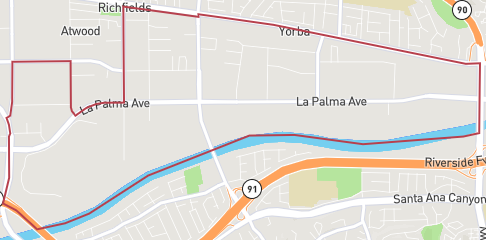
REAL ESTATE PRICES & OVERVIEW
Lake Summit / Galerie median real estate price is $968,329, which is more expensive than 68.0% of the neighborhoods in California and 92.4% of the neighborhoods in the U.S.
The average rental price in Lake Summit / Galerie is currently $6,419, based on NeighborhoodScout's exclusive analysis. The average rental cost in this neighborhood is higher than 98.7% of the neighborhoods in California.
Lake Summit / Galerie is a suburban neighborhood (based on population density) located in Anaheim, California.
Lake Summit / Galerie real estate is primarily made up of medium sized (three or four bedroom) to large (four, five or more bedroom) single-family homes and townhomes. Most of the residential real estate is owner occupied. Many of the residences in the Lake Summit / Galerie neighborhood are established but not old, having been built between 1970 and 1999. A number of residences were also built between 2000 and the present.
In Lake Summit / Galerie, the current vacancy rate is 0.0%, which is a lower rate of vacancies than 100.0% of all neighborhoods in the U.S. This means that the housing supply in Lake Summit / Galerie is very tight compared to the demand for property here.
NOTABLE & UNIQUE NEIGHBORHOOD CHARACTERISTICS
When you see a neighborhood for the first time, the most important thing is often the way it looks, like its homes and its setting. Some places look the same, but they only reveal their true character after living in them for a while because they contain a unique mix of occupational or cultural groups. This neighborhood is very unique in some important ways, according to NeighborhoodScout's exclusive exploration and analysis.
Real Estate
This neighborhood has the distinction of having one of the lowest real estate vacancy rates of any neighborhood in America. With just 0.0% of the real estate vacant, this indicates an exceptionally strong demand for real estate in the Lake Summit / Galerie neighborhood, and/or an issue with creating enough supply for the demand. This could have the effect of increasing real estate prices, increasing supply to meet demand, or both.
In addition, if you love row houses and attached homes, you will probably really like the Lake Summit / Galerie neighborhood. The ambiance, the charm, of row houses is something special. And in sheer abundance of row houses, this neighborhood truly stands out. The real estate here has a higher proportion of row houses and attached homes than nearly any neighborhood in America. In fact, 30.8% of the residential real estate here is classified as row houses and attached homes.
People
Wealth makes most things in life easier, and a few things harder. If you are wealthy and enjoy keeping up with the Jones', this neighborhood will interest you. In fact, according to NeighborhoodScout's research, the Lake Summit / Galerie neighborhood is wealthier than 96.6% of the neighborhoods in the United States. Residents here are truly in a unique situation even when compared to other Americans, based on the sheer amount of wealth concentrated here. Even in times of economic downturn, residents of this neighborhood, as a group, suffered less and recovered more quickly. This is indeed a stand-out characteristic of this neighborhood.
Diversity
Did you know that the Lake Summit / Galerie neighborhood has more Belgian and Czechoslovakian ancestry people living in it than nearly any neighborhood in America? It's true! In fact, 1.0% of this neighborhood's residents have Belgian ancestry and 0.7% have Czechoslovakian ancestry.
Lake Summit / Galerie is also pretty special linguistically. Significantly, 2.9% of its residents five years old and above primarily speak Persian at home. While this may seem like a small percentage, it is higher than 99.5% of the neighborhoods in America.
THE NEIGHBORS
There are two complementary measures for understanding the income of a neighborhood's residents: the average and the extremes. While a neighborhood may be relatively wealthy overall, it is equally important to understand the rate of people - particularly children - who are living at or below the federal poverty line, which is extremely low income. Some neighborhoods with a lower average income may actually have a lower childhood poverty rate than another with a higher average income, and this helps us understand the conditions and character of a neighborhood.
The neighbors in the Lake Summit / Galerie neighborhood in Anaheim are wealthy, making it among the 15% highest income neighborhoods in America. NeighborhoodScout's exclusive analysis reveals that this neighborhood has a higher income than 96.6% of the neighborhoods in America. In addition, 1.6% of the children seventeen and under living in this neighborhood are living below the federal poverty line, which is a lower rate of childhood poverty than is found in 76.9% of America's neighborhoods.
The old saying "you are what you eat" is true. But it is also true that you are what you do for a living. The types of occupations your neighbors have shape their character, and together as a group, their collective occupations shape the culture of a place.
In the Lake Summit / Galerie neighborhood, 57.7% of the working population is employed in executive, management, and professional occupations. The second most important occupational group in this neighborhood is sales and service jobs, from major sales accounts, to working in fast food restaurants, with 19.6% of the residents employed. Other residents here are employed in clerical, assistant, and tech support occupations (12.9%), and 9.5% in manufacturing and laborer occupations.
Languages
The languages spoken by people in this neighborhood are diverse. These are tabulated as the languages people preferentially speak when they are at home with their families. The most common language spoken in the Lake Summit / Galerie neighborhood is English, spoken by 75.7% of households. Other important languages spoken here include Spanish, Langs. of India, Chinese and Persian.
Ethnicity / Ancestry
Boston's Beacon Hill blue-blood streets, Brooklyn's Orthodox Jewish enclaves, Los Angeles' Persian neighborhoods. Each has its own culture derived primarily from the ancestries and culture of the residents who call these neighborhoods home. Likewise, each neighborhood in America has its own culture – some more unique than others – based on lifestyle, occupations, the types of households – and importantly – on the ethnicities and ancestries of the people who live in the neighborhood. Understanding where people came from, who their grandparents or great-grandparents were, can help you understand how a neighborhood is today.
In the Lake Summit / Galerie neighborhood in Anaheim, CA, residents most commonly identify their ethnicity or ancestry as Asian (27.2%). There are also a number of people of German ancestry (13.2%), and residents who report English roots (10.7%), and some of the residents are also of Mexican ancestry (10.4%), along with some Irish ancestry residents (8.7%), among others. In addition, 21.7% of the residents of this neighborhood were born in another country.
GETTING TO WORK
How you get to work – car, bus, train or other means – and how much of your day it takes to do so is a large quality of life and financial issue. Especially with gasoline prices rising and expected to continue doing so, the length and means of one's commute can be a financial burden. Some neighborhoods are physically located so that many residents have to drive in their own car, others are set up so many walk to work, or can take a train, bus, or bike. The greatest number of commuters in Lake Summit / Galerie neighborhood spend between 15 and 30 minutes commuting one-way to work (36.8% of working residents), which is shorter than the time spent commuting to work for most Americans.
Here most residents (80.2%) drive alone in a private automobile to get to work. In addition, quite a number also carpool with coworkers, friends, or neighbors to get to work (5.4%) . In a neighborhood like this, as in most of the nation, many residents find owning a car useful for getting to work.
- Rancho Yorba / Westridge
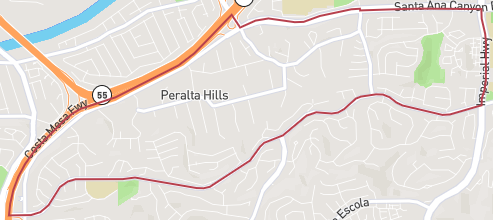
REAL ESTATE PRICES & OVERVIEW
Rancho Yorba / Westridge median real estate price is $1,183,409, which is more expensive than 73.0% of the neighborhoods in California and 93.2% of the neighborhoods in the U.S.
The average rental price in Rancho Yorba / Westridge is currently $4,187, based on NeighborhoodScout's exclusive analysis. The average rental cost in this neighborhood is higher than 74.8% of the neighborhoods in California.
Rancho Yorba / Westridge is a suburban neighborhood (based on population density) located in Anaheim, California.
Rancho Yorba / Westridge real estate is primarily made up of medium sized (three or four bedroom) to large (four, five or more bedroom) single-family homes and townhomes. Most of the residential real estate is owner occupied. Many of the residences in the Rancho Yorba / Westridge neighborhood are established but not old, having been built between 1970 and 1999. A number of residences were also built between 1940 and 1969.
In Rancho Yorba / Westridge, the current vacancy rate is 1.3%, which is a lower rate of vacancies than 91.1% of all neighborhoods in the U.S. This means that the housing supply in Rancho Yorba / Westridge is very tight compared to the demand for property here.
NOTABLE & UNIQUE NEIGHBORHOOD CHARACTERISTICS
Many things matter about a neighborhood, but the first thing most people notice is the way a neighborhood looks and its particular character. For example, one might notice whether the buildings all date from a certain time period or whether shop signs are in multiple languages. This particular neighborhood in Anaheim, the Rancho Yorba / Westridge neighborhood, has some outstanding things about the way it looks and its way of life that are worth highlighting.
Diversity
Did you know that the Rancho Yorba / Westridge neighborhood has more Yugoslav ancestry people living in it than nearly any neighborhood in America? It's true! In fact, 1.7% of this neighborhood's residents have Yugoslav ancestry.
Rancho Yorba / Westridge is also pretty special linguistically. Significantly, 2.3% of its residents five years old and above primarily speak Persian at home. While this may seem like a small percentage, it is higher than 99.3% of the neighborhoods in America.
THE NEIGHBORS
How wealthy a neighborhood is, from very wealthy, to middle income, to low income is very formative with regard to the personality and character of a neighborhood. Equally important is the rate of people, particularly children, who live below the federal poverty line. In some wealthy gated communities, the areas immediately surrounding can have high rates of childhood poverty, which indicates other social issues. NeighborhoodScout's analysis reveals both aspects of income and poverty for this neighborhood.
The neighbors in the Rancho Yorba / Westridge neighborhood in Anaheim are wealthy, making it among the 15% highest income neighborhoods in America. NeighborhoodScout's exclusive analysis reveals that this neighborhood has a higher income than 92.7% of the neighborhoods in America. In addition, 1.1% of the children seventeen and under living in this neighborhood are living below the federal poverty line, which is a lower rate of childhood poverty than is found in 78.5% of America's neighborhoods.
A neighborhood is far different if it is dominated by enlisted military personnel rather than people who earn their living by farming. It is also different if most of the neighbors are clerical support or managers. What is wonderful is the sheer diversity of neighborhoods, allowing you to find the type that fits your lifestyle and aspirations.
In the Rancho Yorba / Westridge neighborhood, 50.3% of the working population is employed in executive, management, and professional occupations. The second most important occupational group in this neighborhood is sales and service jobs, from major sales accounts, to working in fast food restaurants, with 32.5% of the residents employed. Other residents here are employed in clerical, assistant, and tech support occupations (13.5%), and 6.1% in government jobs, whether they are in local, state, or federal positions.
Languages
The languages spoken by people in this neighborhood are diverse. These are tabulated as the languages people preferentially speak when they are at home with their families. The most common language spoken in the Rancho Yorba / Westridge neighborhood is English, spoken by 73.2% of households. Other important languages spoken here include Spanish, Langs. of India, Korean and Persian.
Ethnicity / Ancestry
Culture is shared learned behavior. We learn it from our parents, their parents, our houses of worship, and much of our culture – our learned behavior – comes from our ancestors. That is why ancestry and ethnicity can be so interesting and important to understand: places with concentrations of people of one or more ancestries often express those shared learned behaviors and this gives each neighborhood its own culture. Even different neighborhoods in the same city can have drastically different cultures.
In the Rancho Yorba / Westridge neighborhood in Anaheim, CA, residents most commonly identify their ethnicity or ancestry as Asian (18.9%). There are also a number of people of German ancestry (15.7%), and residents who report Mexican roots (14.1%), and some of the residents are also of Irish ancestry (10.9%), along with some English ancestry residents (9.0%), among others. In addition, 18.2% of the residents of this neighborhood were born in another country.
GETTING TO WORK
How you get to work – car, bus, train or other means – and how much of your day it takes to do so is a large quality of life and financial issue. Especially with gasoline prices rising and expected to continue doing so, the length and means of one's commute can be a financial burden. Some neighborhoods are physically located so that many residents have to drive in their own car, others are set up so many walk to work, or can take a train, bus, or bike. The greatest number of commuters in Rancho Yorba / Westridge neighborhood spend between 15 and 30 minutes commuting one-way to work (35.7% of working residents), which is shorter than the time spent commuting to work for most Americans.
Here most residents (77.0%) drive alone in a private automobile to get to work. In addition, quite a number also carpool with coworkers, friends, or neighbors to get to work (7.4%) . In a neighborhood like this, as in most of the nation, many residents find owning a car useful for getting to work.
- Southeast Anaheim
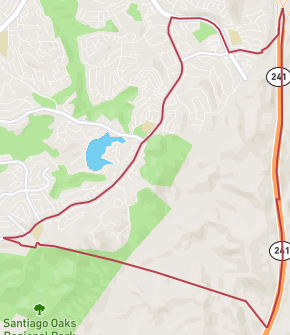
REAL ESTATE PRICES & OVERVIEW
Southeast Anaheim median real estate price is $914,744, which is more expensive than 64.7% of the neighborhoods in California and 91.5% of the neighborhoods in the U.S.
The average rental price in Southeast Anaheim is currently $3,513, based on NeighborhoodScout's exclusive analysis. Rents here are currently lower in price than 41.9% of California neighborhoods.
Southeast Anaheim is an urban neighborhood (based on population density) located in Anaheim, California.
Southeast Anaheim real estate is primarily made up of medium sized (three or four bedroom) to small (studio to two bedroom) single-family homes and apartment complexes/high-rise apartments. Most of the residential real estate is occupied by a mixture of owners and renters. Many of the residences in the Southeast Anaheim neighborhood are established but not old, having been built between 1970 and 1999. A number of residences were also built between 1940 and 1969.
In Southeast Anaheim, the current vacancy rate is 2.8%, which is a lower rate of vacancies than 82.4% of all neighborhoods in the U.S. This means that the housing supply in Southeast Anaheim is very tight compared to the demand for property here.
NOTABLE & UNIQUE NEIGHBORHOOD CHARACTERISTICS
The way a neighborhood looks and feels when you walk or drive around it, from its setting, its buildings, and its flavor, can make all the difference. This neighborhood has some really cool things about the way it looks and feels as revealed by NeighborhoodScout's exclusive research. This might include anything from the housing stock to the types of households living here to how people get around.
Diversity
Significantly, 4.0% of its residents five years old and above primarily speak Tagalog, which is the first language of the Philippine region, at home. While this may seem like a small percentage, it is higher than 97.2% of the neighborhoods in America.
THE NEIGHBORS
There are two complementary measures for understanding the income of a neighborhood's residents: the average and the extremes. While a neighborhood may be relatively wealthy overall, it is equally important to understand the rate of people - particularly children - who are living at or below the federal poverty line, which is extremely low income. Some neighborhoods with a lower average income may actually have a lower childhood poverty rate than another with a higher average income, and this helps us understand the conditions and character of a neighborhood.
The neighbors in the Southeast Anaheim neighborhood in Anaheim are upper-middle income, making it an above average income neighborhood. NeighborhoodScout's exclusive analysis reveals that this neighborhood has a higher income than 66.2% of the neighborhoods in America. With 19.2% of the children here below the federal poverty line, this neighborhood has a higher rate of childhood poverty than 66.6% of U.S. neighborhoods.
A neighborhood is far different if it is dominated by enlisted military personnel rather than people who earn their living by farming. It is also different if most of the neighbors are clerical support or managers. What is wonderful is the sheer diversity of neighborhoods, allowing you to find the type that fits your lifestyle and aspirations.
In the Southeast Anaheim neighborhood, 27.2% of the working population is employed in sales and service jobs, from major sales accounts, to working in fast food restaurants. The second most important occupational group in this neighborhood is executive, management, and professional occupations, with 25.9% of the residents employed. Other residents here are employed in manufacturing and laborer occupations (23.7%), and 21.0% in clerical, assistant, and tech support occupations.
Languages
The languages spoken by people in this neighborhood are diverse. These are tabulated as the languages people preferentially speak when they are at home with their families. The most common language spoken in the Southeast Anaheim neighborhood is Spanish, spoken by 48.6% of households. Other important languages spoken here include English, Chinese and Tagalog (the first language of the Philippine region).
Ethnicity / Ancestry
Boston's Beacon Hill blue-blood streets, Brooklyn's Orthodox Jewish enclaves, Los Angeles' Persian neighborhoods. Each has its own culture derived primarily from the ancestries and culture of the residents who call these neighborhoods home. Likewise, each neighborhood in America has its own culture – some more unique than others – based on lifestyle, occupations, the types of households – and importantly – on the ethnicities and ancestries of the people who live in the neighborhood. Understanding where people came from, who their grandparents or great-grandparents were, can help you understand how a neighborhood is today.
In the Southeast Anaheim neighborhood in Anaheim, CA, residents most commonly identify their ethnicity or ancestry as Mexican (51.8%). There are also a number of people of Asian ancestry (10.6%), and residents who report German roots (7.4%), and some of the residents are also of Irish ancestry (6.5%), along with some English ancestry residents (3.1%), among others. In addition, 37.6% of the residents of this neighborhood were born in another country.
GETTING TO WORK
How you get to work – car, bus, train or other means – and how much of your day it takes to do so is a large quality of life and financial issue. Especially with gasoline prices rising and expected to continue doing so, the length and means of one's commute can be a financial burden. Some neighborhoods are physically located so that many residents have to drive in their own car, others are set up so many walk to work, or can take a train, bus, or bike. The greatest number of commuters in Southeast Anaheim neighborhood spend between 15 and 30 minutes commuting one-way to work (40.6% of working residents), which is shorter than the time spent commuting to work for most Americans.
Here most residents (71.9%) drive alone in a private automobile to get to work. In addition, quite a number also carpool with coworkers, friends, or neighbors to get to work (18.5%) . In a neighborhood like this, as in most of the nation, many residents find owning a car useful for getting to work.
- Sunflower / Bel Air
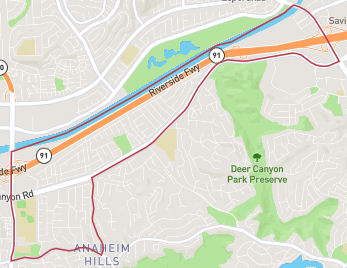
REAL ESTATE PRICES & OVERVIEW
Sunflower / Bel Air median real estate price is $971,970, which is more expensive than 67.8% of the neighborhoods in California and 92.3% of the neighborhoods in the U.S.
The average rental price in Sunflower / Bel Air is currently $4,660, based on NeighborhoodScout's exclusive analysis. The average rental cost in this neighborhood is higher than 83.3% of the neighborhoods in California.
Sunflower / Bel Air is a rural neighborhood (based on population density) located in Anaheim, California.
Sunflower / Bel Air real estate is primarily made up of medium sized (three or four bedroom) to small (studio to two bedroom) single-family homes and apartment complexes/high-rise apartments. Most of the residential real estate is owner occupied. Many of the residences in the Sunflower / Bel Air neighborhood are established but not old, having been built between 1970 and 1999. A number of residences were also built between 2000 and the present.
Real estate vacancies in Sunflower / Bel Air are 3.7%, which is lower than one will find in 76.7% of American neighborhoods. Demand for real estate in Sunflower / Bel Air is above average for the U.S., and may signal some demand for either price increases or new construction of residential product for this neighborhood.
NOTABLE & UNIQUE NEIGHBORHOOD CHARACTERISTICS
When you see a neighborhood for the first time, the most important thing is often the way it looks, like its homes and its setting. Some places look the same, but they only reveal their true character after living in them for a while because they contain a unique mix of occupational or cultural groups. This neighborhood is very unique in some important ways, according to NeighborhoodScout's exclusive exploration and analysis.
Real Estate
Most neighborhoods are composed of a mixture of ages of homes, but the Sunflower / Bel Air stands out as rather unique in having nearly all of its residential real estate built in one time period, namely between 1970 and 1999, generally considered to be established, but not old housing. What you'll sense when you look around or drive the streets of this neighborhood is that many of the residences look the same because of this similarity of age. In fact, 91.0% of the residential real estate here was built in this one time period.
People
If you're planning where to retire, the Sunflower / Bel Air neighborhood in Anaheim is a great option to consider. According to NeighborhoodScout's exclusive retirement dream area analysis, it's peaceful and quiet, has above average safety ratings compared to other neighborhoods in CA, offers a wide range of housing options, and has already attracted an enviable mix of college educated seniors. This neighborhood ranks as better for retirement living than 88.1% of the neighborhoods in California. If you are considering retiring to California, this is a good neighborhood to look at.
Diversity
Did you know that the Sunflower / Bel Air neighborhood has more Iranian and Asian ancestry people living in it than nearly any neighborhood in America? It's true! In fact, 2.0% of this neighborhood's residents have Iranian ancestry and 23.9% have Asian ancestry.
Sunflower / Bel Air is also pretty special linguistically. Significantly, 1.9% of its residents five years old and above primarily speak Persian at home. While this may seem like a small percentage, it is higher than 99.1% of the neighborhoods in America.
THE NEIGHBORS
There are two complementary measures for understanding the income of a neighborhood's residents: the average and the extremes. While a neighborhood may be relatively wealthy overall, it is equally important to understand the rate of people - particularly children - who are living at or below the federal poverty line, which is extremely low income. Some neighborhoods with a lower average income may actually have a lower childhood poverty rate than another with a higher average income, and this helps us understand the conditions and character of a neighborhood.
The neighbors in the Sunflower / Bel Air neighborhood in Anaheim are wealthy, making it among the 15% highest income neighborhoods in America. NeighborhoodScout's exclusive analysis reveals that this neighborhood has a higher income than 93.8% of the neighborhoods in America. In addition, 6.1% of the children seventeen and under living in this neighborhood are living below the federal poverty line, which is a lower rate of childhood poverty than is found in 61.9% of America's neighborhoods.
What we choose to do for a living reflects who we are. Each neighborhood has a different mix of occupations represented, and together these tell you about the neighborhood and help you understand if this neighborhood may fit your lifestyle.
In the Sunflower / Bel Air neighborhood, 58.2% of the working population is employed in executive, management, and professional occupations. The second most important occupational group in this neighborhood is sales and service jobs, from major sales accounts, to working in fast food restaurants, with 20.1% of the residents employed. Other residents here are employed in clerical, assistant, and tech support occupations (12.2%), and 8.6% in manufacturing and laborer occupations.
Languages
The languages spoken by people in this neighborhood are diverse. These are tabulated as the languages people preferentially speak when they are at home with their families. The most common language spoken in the Sunflower / Bel Air neighborhood is English, spoken by 69.3% of households. Other important languages spoken here include Spanish, Langs. of India, Arabic and Tagalog (the first language of the Philippine region).
Ethnicity / Ancestry
Culture is shared learned behavior. We learn it from our parents, their parents, our houses of worship, and much of our culture – our learned behavior – comes from our ancestors. That is why ancestry and ethnicity can be so interesting and important to understand: places with concentrations of people of one or more ancestries often express those shared learned behaviors and this gives each neighborhood its own culture. Even different neighborhoods in the same city can have drastically different cultures.
In the Sunflower / Bel Air neighborhood in Anaheim, CA, residents most commonly identify their ethnicity or ancestry as Asian (23.9%). There are also a number of people of English ancestry (13.8%), and residents who report German roots (13.7%), and some of the residents are also of Mexican ancestry (12.8%), along with some Irish ancestry residents (8.7%), among others. In addition, 25.0% of the residents of this neighborhood were born in another country.
GETTING TO WORK
Even if your neighborhood is walkable, you may still have to drive to your place of work. Some neighborhoods are located where many can get to work in just a few minutes, while others are located such that most residents have a long and arduous commute. The greatest number of commuters in Sunflower / Bel Air neighborhood spend between 30 and 45 minutes commuting one-way to work (35.7% of working residents), which is at or a bit above the average length of a commute across all U.S. neighborhoods.
Here most residents (85.7%) drive alone in a private automobile to get to work. In a neighborhood like this, as in most of the nation, many residents find owning a car useful for getting to work.
- The Summit of Anaheim Hills
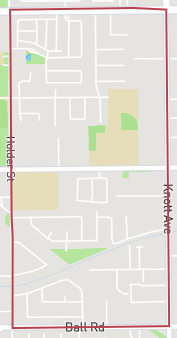
REAL ESTATE PRICES & OVERVIEW
The Summit of Anaheim Hills median real estate price is $914,899, which is more expensive than 56.7% of the neighborhoods in California and 88.1% of the neighborhoods in the U.S.
The average rental price in The Summit of Anaheim Hills is currently $5,056, based on NeighborhoodScout's exclusive analysis. The average rental cost in this neighborhood is higher than 88.8% of the neighborhoods in California.
The Summit of Anaheim Hills is a suburban neighborhood (based on population density) located in Anaheim, California.
The Summit of Anaheim Hills real estate is primarily made up of medium sized (three or four bedroom) to large (four, five or more bedroom) single-family homes and townhomes. Most of the residential real estate is owner occupied. Many of the residences in the The Summit of Anaheim Hills neighborhood are established but not old, having been built between 1970 and 1999. A number of residences were also built between 2000 and the present.
In The Summit of Anaheim Hills, the current vacancy rate is 0.0%, which is a lower rate of vacancies than 100.0% of all neighborhoods in the U.S. This means that the housing supply in The Summit of Anaheim Hills is very tight compared to the demand for property here.
NOTABLE & UNIQUE NEIGHBORHOOD CHARACTERISTICS
Many things matter about a neighborhood, but the first thing most people notice is the way a neighborhood looks and its particular character. For example, one might notice whether the buildings all date from a certain time period or whether shop signs are in multiple languages. This particular neighborhood in Anaheim, the The Summit of Anaheim Hills neighborhood, has some outstanding things about the way it looks and its way of life that are worth highlighting.
Real Estate
With a real estate vacancy rate of only 0.0%, the The Summit of Anaheim Hills neighborhood has a lower vacancy rate than 100.0% of U.S. neighborhoods, a very elite group. Such a low vacancy rate may indicate very strong real estate demand in the neighborhood combined with some impediments to increasing supply, such as zoning or existing density of development, among other potential reasons.
In addition, if you love row houses and attached homes, you will probably really like the The Summit of Anaheim Hills neighborhood. The ambiance, the charm, of row houses is something special. And in sheer abundance of row houses, this neighborhood truly stands out. The real estate here has a higher proportion of row houses and attached homes than nearly any neighborhood in America. In fact, 44.1% of the residential real estate here is classified as row houses and attached homes.
Furthermore, most neighborhoods are composed of a mixture of ages of homes, but the The Summit of Anaheim Hills stands out as rather unique in having nearly all of its residential real estate built in one time period, namely between 1970 and 1999, generally considered to be established, but not old housing. What you'll sense when you look around or drive the streets of this neighborhood is that many of the residences look the same because of this similarity of age. In fact, 82.2% of the residential real estate here was built in this one time period.
People
If you're looking for a great spot to raise a family, then look no further than the The Summit of Anaheim Hills neighborhood. NeighborhoodScout's analysis found that the combination of good quality public schools, above-average safety from crime, and a high rate of home ownership in predominantly single-family homes, help make this neighborhood among the top 14.5% of family-friendly neighborhoods across the state of California. In addition, there are a high proportion of other families with school-aged children living here, making it easy for parents and their children to socialize and develop a sense of community support. In addition, families here highly value education, as is reflected by the strength of the local schools, in part due to the educational attainment of the parents here, who vote in support of the public schools.
Diversity
Did you know that the The Summit of Anaheim Hills neighborhood has more Iranian and Lithuanian ancestry people living in it than nearly any neighborhood in America? It's true! In fact, 6.6% of this neighborhood's residents have Iranian ancestry and 1.3% have Lithuanian ancestry.
The Summit of Anaheim Hills is also pretty special linguistically. Significantly, 1.2% of its residents five years old and above primarily speak Persian at home. While this may seem like a small percentage, it is higher than 98.1% of the neighborhoods in America.
THE NEIGHBORS
There are two complementary measures for understanding the income of a neighborhood's residents: the average and the extremes. While a neighborhood may be relatively wealthy overall, it is equally important to understand the rate of people - particularly children - who are living at or below the federal poverty line, which is extremely low income. Some neighborhoods with a lower average income may actually have a lower childhood poverty rate than another with a higher average income, and this helps us understand the conditions and character of a neighborhood.
The neighbors in the The Summit of Anaheim Hills neighborhood in Anaheim are wealthy, making it among the 15% highest income neighborhoods in America. NeighborhoodScout's exclusive analysis reveals that this neighborhood has a higher income than 93.5% of the neighborhoods in America. In addition, 2.7% of the children seventeen and under living in this neighborhood are living below the federal poverty line, which is a lower rate of childhood poverty than is found in 73.0% of America's neighborhoods.
A neighborhood is far different if it is dominated by enlisted military personnel rather than people who earn their living by farming. It is also different if most of the neighbors are clerical support or managers. What is wonderful is the sheer diversity of neighborhoods, allowing you to find the type that fits your lifestyle and aspirations.
In the The Summit of Anaheim Hills neighborhood, 60.9% of the working population is employed in executive, management, and professional occupations. The second most important occupational group in this neighborhood is sales and service jobs, from major sales accounts, to working in fast food restaurants, with 22.9% of the residents employed. Other residents here are employed in clerical, assistant, and tech support occupations (10.4%), and 8.4% in government jobs, whether they are in local, state, or federal positions.
Languages
The languages spoken by people in this neighborhood are diverse. These are tabulated as the languages people preferentially speak when they are at home with their families. The most common language spoken in the The Summit of Anaheim Hills neighborhood is English, spoken by 70.3% of households. Other important languages spoken here include Tagalog (the first language of the Philippine region), Spanish, Langs. of India and Vietnamese.
Ethnicity / Ancestry
Culture is the shared learned behavior of peoples. Undeniably, different ethnicities and ancestries have different cultural traditions, and as a result, neighborhoods with concentrations of residents of one or another ethnicities or ancestries will express those cultures. It is what makes the North End in Boston so fun to visit for the Italian restaurants, bakeries, culture, and charm, and similarly, why people enjoy visiting Chinatown in San Francisco.
In the The Summit of Anaheim Hills neighborhood in Anaheim, CA, residents most commonly identify their ethnicity or ancestry as Asian (26.2%). There are also a number of people of German ancestry (14.5%), and residents who report Italian roots (9.2%), and some of the residents are also of Irish ancestry (8.9%), along with some Irania ancestry residents (6.6%), among others. In addition, 27.0% of the residents of this neighborhood were born in another country.
GETTING TO WORK
How you get to work – car, bus, train or other means – and how much of your day it takes to do so is a large quality of life and financial issue. Especially with gasoline prices rising and expected to continue doing so, the length and means of one's commute can be a financial burden. Some neighborhoods are physically located so that many residents have to drive in their own car, others are set up so many walk to work, or can take a train, bus, or bike. The greatest number of commuters in The Summit of Anaheim Hills neighborhood spend between 15 and 30 minutes commuting one-way to work (39.6% of working residents), which is shorter than the time spent commuting to work for most Americans.
Here most residents (81.9%) drive alone in a private automobile to get to work. In addition, quite a number also carpool with coworkers, friends, or neighbors to get to work (5.8%) . In a neighborhood like this, as in most of the nation, many residents find owning a car useful for getting to work.
|
 Cerritos
Cerritos La Palma
La Palma Anaheim
Anaheim  Cypress
Cypress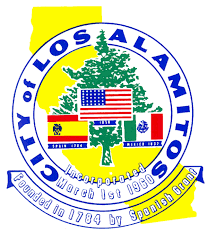 Los Alamitos
Los Alamitos Buena Park
Buena Park